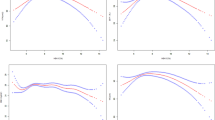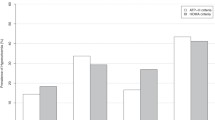Abstract
Background
Visceral Adiposity Index (VAI) is a gender-specific mathematical model based on BMI, waist circumference (WC) and lipid parameters. No study has yet examined the relationship between this index and the glycemic and metabolic parameters in children and adolescents with Type 1 Diabetes Mellitus (DM). The current study aims at examining the relationship between glycemic and metabolic control and VAI in children and adolescents with Type 1 DM.
Methods
A total of 150 children and adolescents aged 6–18 years with Type 1 DM were included in this study. Anthropometric, glycemic and metabolic parameters were examined. VAI was calculated using gender-specific formulas. Statistical analysis was done by SPSS version 23.
Results
The average age of the participants was 12.2 ± 3.1 years (females 53.0%). The females had higher rates of VAI, microalbuminuria and hypertension than males. Participants of both gender with higher VAI quartiles had higher anthropometric measurements, insulin usage, low-density lipoprotein cholesterol (LDL-C), triglycerides and urine microalbumin and had poor glycemic control. Sex adjusted correlation analysis showed that VAI is negatively correlated with estimated glucose disposal rate (eGDR), and positively correlated with insulin dose, LDL-C, triglycerides, glycosylated hemoglobin (HbA1c) and microalbuminuria.
Conclusion
The present paper is the first study examining the relationship between Type 1 DM and VAI. Higher VAI values in children and adolescents with type 1 DM may adversely affect glycemic and metabolic control. VAI can be a useful and new method in evaluating glycemic and metabolic control in children and adolescents with Type 1 DM.
Similar content being viewed by others

Data availability
The data that support the findings of this study are available from the corresponding author upon reasonable request.
References
Romanelli R, Cecchi N, Carbone MG et al (2020) Pediatric obesity: prevention is better than care. Ital J Pediatr 46(1):103. https://doi.org/10.1186/s13052-020-00868-7
NCD Risk Factor Collaboration (NCD-RisC) Worldwide trends in body-mass index, underweight, overweight, and obesity from 1975 to 2016: a pooled analysis of 2416 population-based measurement studies in 128·9 million children, adolescents, and adults. Lancet 390(10113):2627–2642. https://doi.org/10.1016/S0140-6736(17)32129-3
Singhal V, Sella AC, Malhotra S (2021) Pharmacotherapy in pediatric obesity: current evidence and landscape. Curr Opin Endocrinol Diabetes Obes 28(1):55–63. https://doi.org/10.1097/MED.0000000000000587
Greydanus DE, Agana M, Kamboj MK et al (2018) Pediatric obesity: Current concepts. Dis Mon 64(4):98–156. https://doi.org/10.1016/j.disamonth.2017.12.001
Turkey Childhood (Primary School 2 Grade Students) (2016) Obesity Surveillance Initiative COSI-TUR, Ankara. Available from: https://hsgm.saglik.gov.tr/depo/birimler/saglikli-beslenme-hareketli-hayatdb/dokumanlar/Ingilizce-Yayinlar/COSI_TUR_2016_/Turkey_Childhood_Obesity_Cosi_tur_2016.pdf Accessed 15 Jun 2020
Kaminski BM, Klingensmith GJ, Beck RW et al (2013) Pediatric Diabetes Consortium. Body mass index at the time of diagnosis of autoimmune type 1 diabetes in children. J Pediatr 162(4):736–740.e1. https://doi.org/10.1016/j.jpeds.2012.09.017
Maffeis C, Birkebaek NH, Konstantinova M et al (2018) Prevalence of underweight, overweight, and obesity in children and adolescents with type 1 diabetes: Data from the international SWEET registry. Pediatr Diabetes 19(7):1211–1220. https://doi.org/10.1111/pedi.12730
Köken ÖY, Kara C, Yilmaz GC, Aydın HA (2020) Utility of estimated glucose disposal rate for predicting metabolic syndrome in children and adolescents with type-1 diabetes. J Pediatr Endocrinol Metab 33(7):859–64. https://doi.org/10.1515/jpem-2020-0012
Al-Daghri NM, Al-Attas OS, Alokail M et al (2014) Does visceral adiposity index signify early metabolic risk in children and adolescents?: association with insulin resistance, adipokines, and subclinical inflammation. Pediatr Res 75(3):459–463. https://doi.org/10.1038/pr.2013.229
Wei J, Liu X, Xue H et al (2019) Comparisons of Visceral Adiposity Index, Body Shape Index, Body Mass Index and Waist Circumference and Their Associations with Diabetes Mellitus in Adults. Nutrients 11(7):1580. https://doi.org/10.3390/nu11071580
Shuster A, Patlas M, Pinthus JH, Mourtzakis M (2012) The clinical importance of visceral adiposity: a critical review of methods for visceral adipose tissue analysis. Br J Radiol 85(1009):1–10. https://doi.org/10.1259/bjr/38447238
Elizalde-Barrera CI, Rubio-Guerra AF, Lozano-Nuevo JJ, Olvera-Gomez JL (2019) Triglycerides and waist to height ratio are more accurate than visceral adiposity and body adiposity index to predict impaired fasting glucose. Diabetes Res Clin Pract 153:49–54. https://doi.org/10.1016/j.diabres.2019.05.019
Ejtahed HS, Kelishadi R, Hasani-Ranjbar S et al (2019) Discriminatory ability of visceral adiposity index as an indicator for modeling cardio-metabolic risk factors in pediatric population: the CASPIAN-V study. J Cardiovasc Thorac Res 11(4):280–286. https://doi.org/10.15171/jcvtr.2019.46
Hameed EK, AbdulQahar ZH (2019) Visceral adiposity index in female with type 2 diabetic mellitus and its association with the glycemic control. Diabetes Metab Syndr Mar-Apr 13(2):1241–1244. https://doi.org/10.1016/j.dsx.2019.01.039
Ciresi A, Amato MC, Pizzolanti G, Giordano GC (2012) Visceral Adiposity Index Is Associated with Insulin Sensitivity and Adipocytokine Levels in Newly Diagnosed Acromegalic Patients. J Clin Endocrinol Metab 97(8):2907–2915. https://doi.org/10.1210/jc.2012-1518
Yang F, Wang G, Wang Z, Sun M et al (2014) Visceral Adiposity Index May Be a Surrogate Marker for the Assessment of the Effects of Obesity on Arterial Stiffness. PLoS One 9(8):e104365. https://doi.org/10.1371/journal.pone.0104365
Vizzuso S, Del Torto A, Dilillo D et al (2021) Visceral Adiposity Index (VAI) in Children and Adolescents with Obesity: No Association with Daily Energy Intake but Promising Tool to Identify Metabolic Syndrome (MetS). Nutrients 13(2):413. https://doi.org/10.3390/nu13020413
Dong Y, Bai L, Cai R et al (2021) Children’s Lipid Accumulation Product Combining Visceral Adiposity Index is a Novel Indicator for Predicting Unhealthy Metabolic Phenotype Among Chinese Children and Adolescents. Diabetes Metab Syndr Obes 23(14):4579–4587. https://doi.org/10.2147/DMSO.S337412
WHO Multicentre Growth Reference Study Group (2006) WHO Child Growth Standards based on length/height, weight and age. Acta Paediatr Suppl 450:76–85. https://doi.org/10.1111/j.1651-2227.2006.tb02378.x
Pediatrics AA (2004) National High Blood Pressure Education program working group on high blood pressure in children and adolescents. Pediatrics 114(2 Suppl 4th Report):555–76
Flynn JT, Kaelber DC, Baker-Smith CM et al (2017) Clinical Practice Guideline for Screening and Management of High Blood Pressure in Children and Adolescents. Pediatrics 140(3):e20171904. https://doi.org/10.1542/peds.2017-1904.
Tuttle KR, Bakrıs GL, Bilous RW et al (2014) Diabetic Kidney Disease: A Report from an ADA Consensus Conference. Diabetes Care 37(10):2864–2883. https://doi.org/10.2337/dc14-1296
Williams KV, Erbey JR, Becker D et al (2000) Can clinical factors estimate insulin resistance in type 1 diabetes? Diabetes 49:626–632. https://doi.org/10.2337/diabetes.49.4.626
Palomo Atance E, Ballester Herrera MJ, Giralt Muiña P et al (2013) Estimated glucose disposal rate in patients under 18 years of age with type 1 diabetes mellitus and overweight or obesity. Endocrinol Nutr 60(7):379–85. https://doi.org/10.1016/j.endonu.2013.02.005
Krochik AG, Botto M, Bravo M (2015) Association between insulin resistance and risk of complications in children and adolescents with type 1 diabetes. Diabetes Metab Syndr 9(1):14–8. https://doi.org/10.1016/j.dsx.2014.09.013
Köken ÖY, Kara C, Yılmaz GC, Aydın HM (2020) Utility of estimated glucose disposal rate for predicting metabolic syndrome in children and adolescents with type-1 diabetes. J Pediatr Endocrinol Metab 33(7):859–864. https://doi.org/10.1515/jpem-2020-0012
Kietsiriroje N, Pearson S, Campbell M et al (2019) Double diabetes: A distinct high-risk group? Diabetes Obes Metab 21(12):2609–2618. https://doi.org/10.1111/dom.13848
Chow SC, Chiu ST (2005) Design and Analysis of Clinical Trials: Concepts and Methodologies, Second Edition, Wiley-Interscience. ISBN 0471249858
Klein S (2010) Is visceral fat responsible for the metabolic abnormalities associated with obesity?: implications of omentectomy. Diabetes Care 33(7):1693–1694. https://doi.org/10.2337/dc10-0744
Taksali SE, Caprio S, Dziura J et al (2008) High visceral and low abdominal subcutaneous fat stores in the obese adolescent: a determinant of an adverse metabolic phenotype. Diabetes 57(2):367–371. https://doi.org/10.2337/db07-0932
Yan Y, Liu J, Zhao X et al (2019) Abdominal visceral and subcutaneous adipose tissues in association with cardiometabolic risk in children and adolescents: the China Child and Adolescent Cardiovascular Health (CCACH) study. BMJ Open Diabetes Res Care 7(1):e000824. https://doi.org/10.1136/bmjdrc-2019-000824
Mohammadreza B, Farzad H, Davoud K, Fereidoun Prof AF (2012) Prognostic significance of the complex “Visceral Adiposity Index” vs. simple anthropometric measures: Tehran lipid and glucose study. Cardiovasc Diabetol 11:20. https://doi.org/10.1186/1475-2840-11-20
Amato MC, Giordano C, Pitrone M, Galluzzo A (2011) Cutoff points of the visceral adiposity index (VAI) identifying a visceral adipose dysfunction associated with cardiometabolic risk in a Caucasian Sicilian population. Lipids Health Dis 19(10):183. https://doi.org/10.1186/1476-511X-10-183
Amato MC, Giordano C, Galia M et al (2010) Visceral adiposity index: A reliable indicator of visceral fat function associated with cardiometabolic risk. Diabetes Care 33(4):920–922. https://doi.org/10.2337/dc09-1825
Wu J, Gong L, Li Q et al (2017) A novel visceral adiposity index for prediction of type 2 diabetes and pre-diabetes in Chinese adults: a 5-year prospective study. Sci Rep 7(1):13784. https://doi.org/10.1038/s41598-017-14251-w
Ji B, Qu H, Wang H et al (2017) Association between the visceral adiposity index and homeostatic model assessment of insulin resistance in participants with normal waist circumference. Angiology 68(8):716–721. https://doi.org/10.1177/0003319716682120
Uruska A, Zozulinska-Ziolkiewicz D, Niedzwiecki P et al (2018) TG/HDL-C ratio and visceral adiposity index may be useful in assessment of insulin resistance in adults with type 1 diabetes in clinical practice. J Clin Lipidol May-Jun 12(3):734–740. https://doi.org/10.1016/j.jacl.2018.01.005
Cao YY, Tang X, Sun KX et al (2017) Relationship between glycemic control and visceral adiposity index among the patients with type 2 diabetes mellitus. Beijing Da Xue Xue Bao Yi Xue Ban 49(3):446–450
Donaghue KC, Marcovecchio ML, Wadwa RP et al (2018) ISPAD Clinical Practice Consensus Guidelines 2018: Microvascular and macrovascular complications in children and adolescents. Pediatr Diabetes 19(Suppl 27):262–274. https://doi.org/10.1111/pedi.12742
Acknowledgements
The authors would like to thank the patients and their parents who participated in this study.
Author information
Authors and Affiliations
Contributions
V.Ö., Ş.Ö.Ö, S.E.A.; contributed to the main study idea and design, V.Ö, Data Collection and/or Processing-Analysis and/or Interpretation, V.Ö, Ş.Ö.Ö, wrote the first draft of the manuscript. Ş.Ö.Ö., S.E.A.; revised and edited the manuscript. V.Ö., Ş.Ö.Ö, S.E.A.; Critical Review. All the authors approved the final submitted manuscript.
Corresponding author
Ethics declarations
Ethics
The ethics committee approval no. 2018-14/38 was obtained from Bursa Uludağ University Non-Interventional Clinical Research Ethics Committee and the research permit no. 73115338-819/38160 was obtained from Bursa Uludağ University Directorate for Health Applied and Research Center. The study conformed to the provision of the Declaration of Helsinki.
Conflicts of interest
The authors declare no conflict of interest.
Additional information
Publisher's Note
Springer Nature remains neutral with regard to jurisdictional claims in published maps and institutional affiliations.
Rights and permissions
Springer Nature or its licensor (e.g. a society or other partner) holds exclusive rights to this article under a publishing agreement with the author(s) or other rightsholder(s); author self-archiving of the accepted manuscript version of this article is solely governed by the terms of such publishing agreement and applicable law.
About this article
Cite this article
Özkaya, V., Özkaya, Ş.Ö. & Adal, S.E. Relationship between visceral adiposity index and glycemic and metabolic control in children and adolescents with type 1 diabetes mellitus. Ir J Med Sci 193, 181–189 (2024). https://doi.org/10.1007/s11845-023-03375-w
Received:
Accepted:
Published:
Issue Date:
DOI: https://doi.org/10.1007/s11845-023-03375-w



